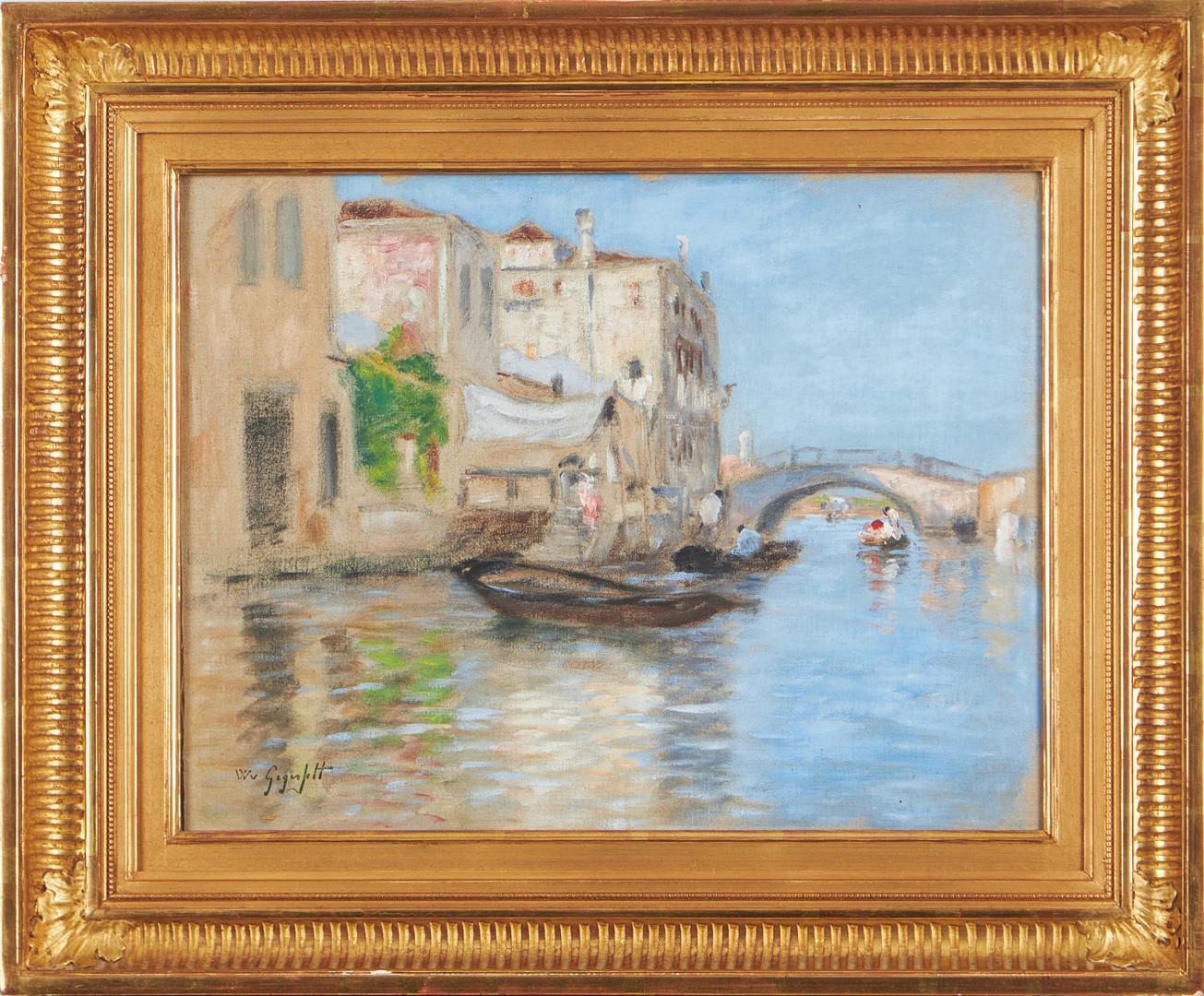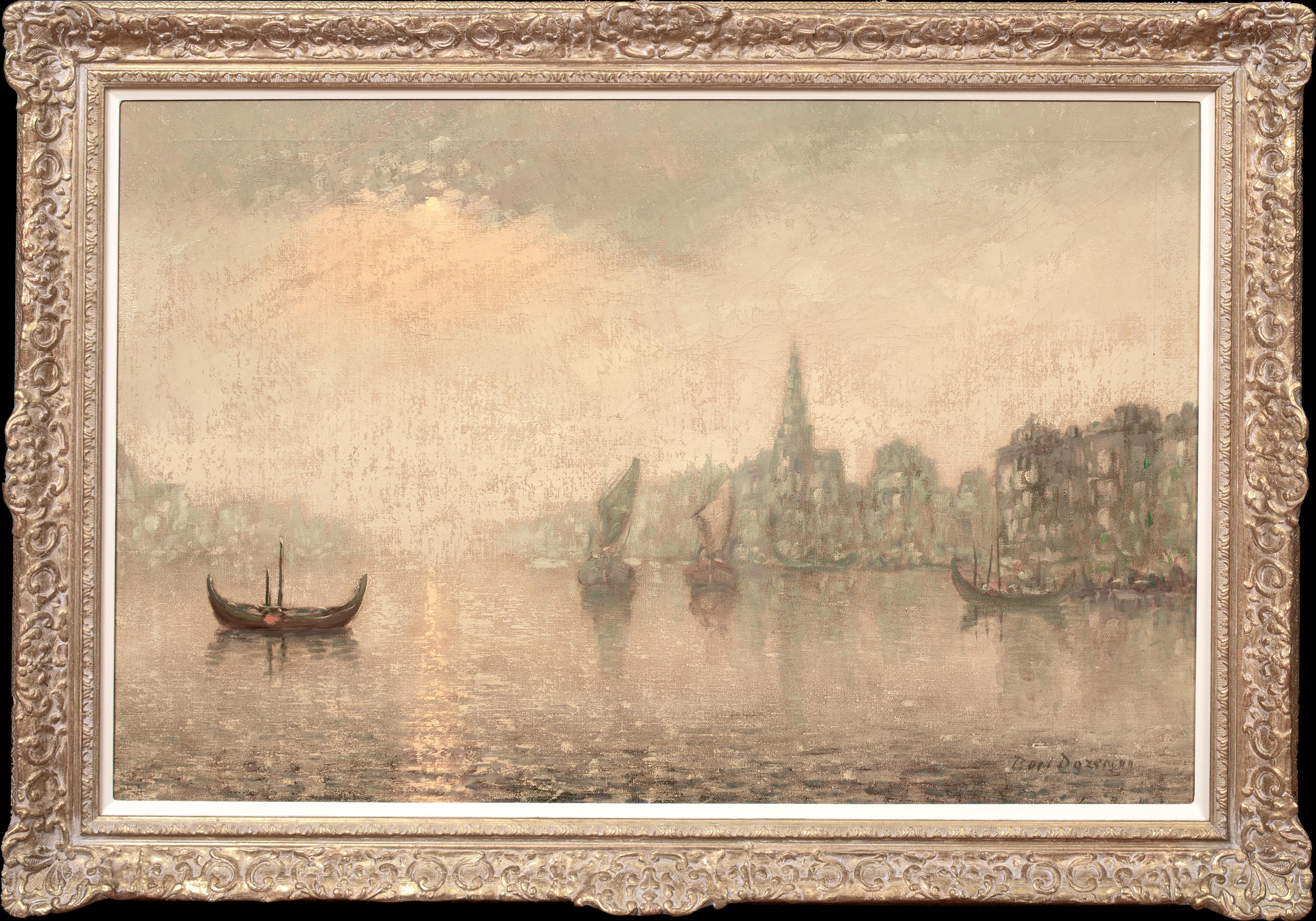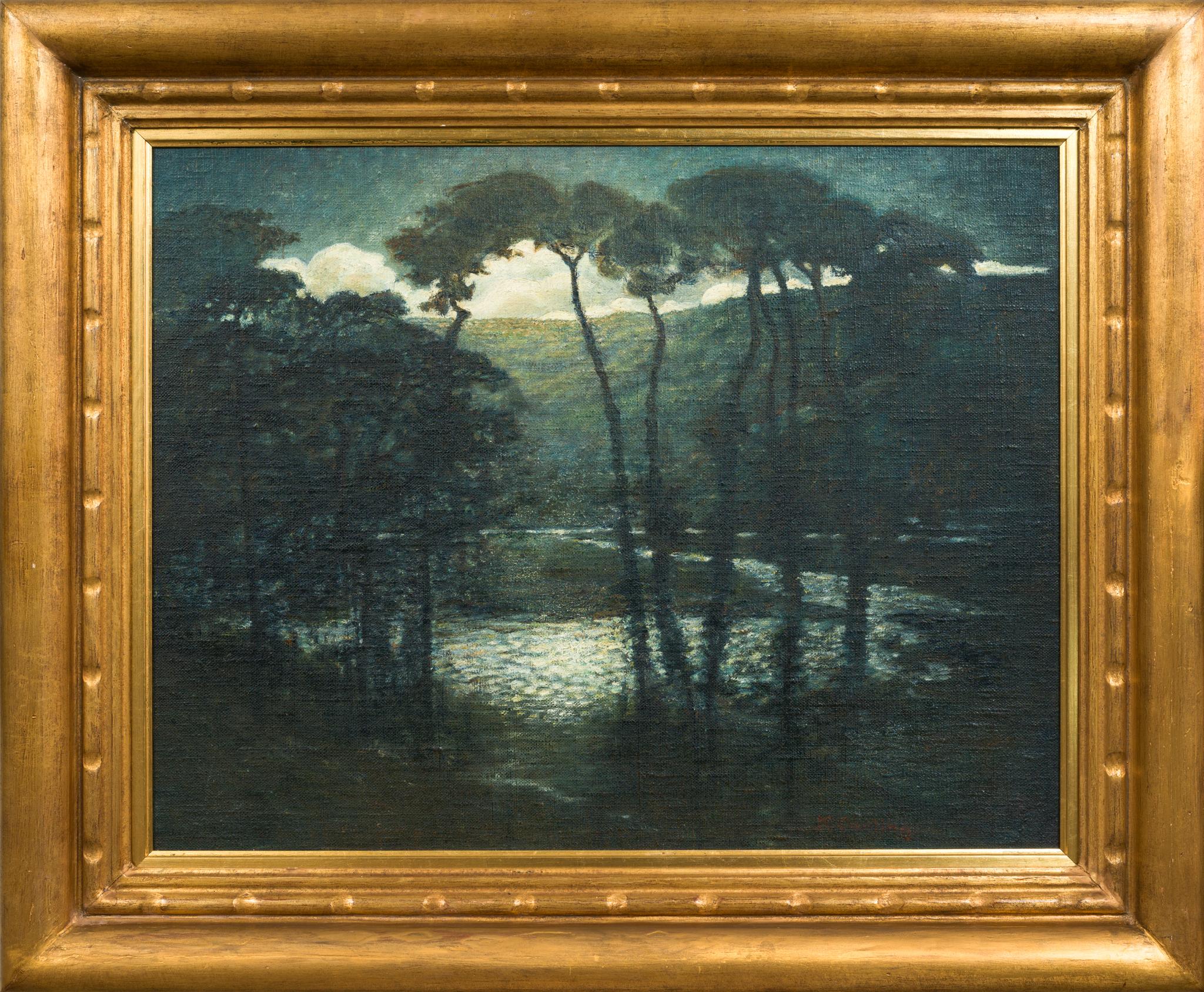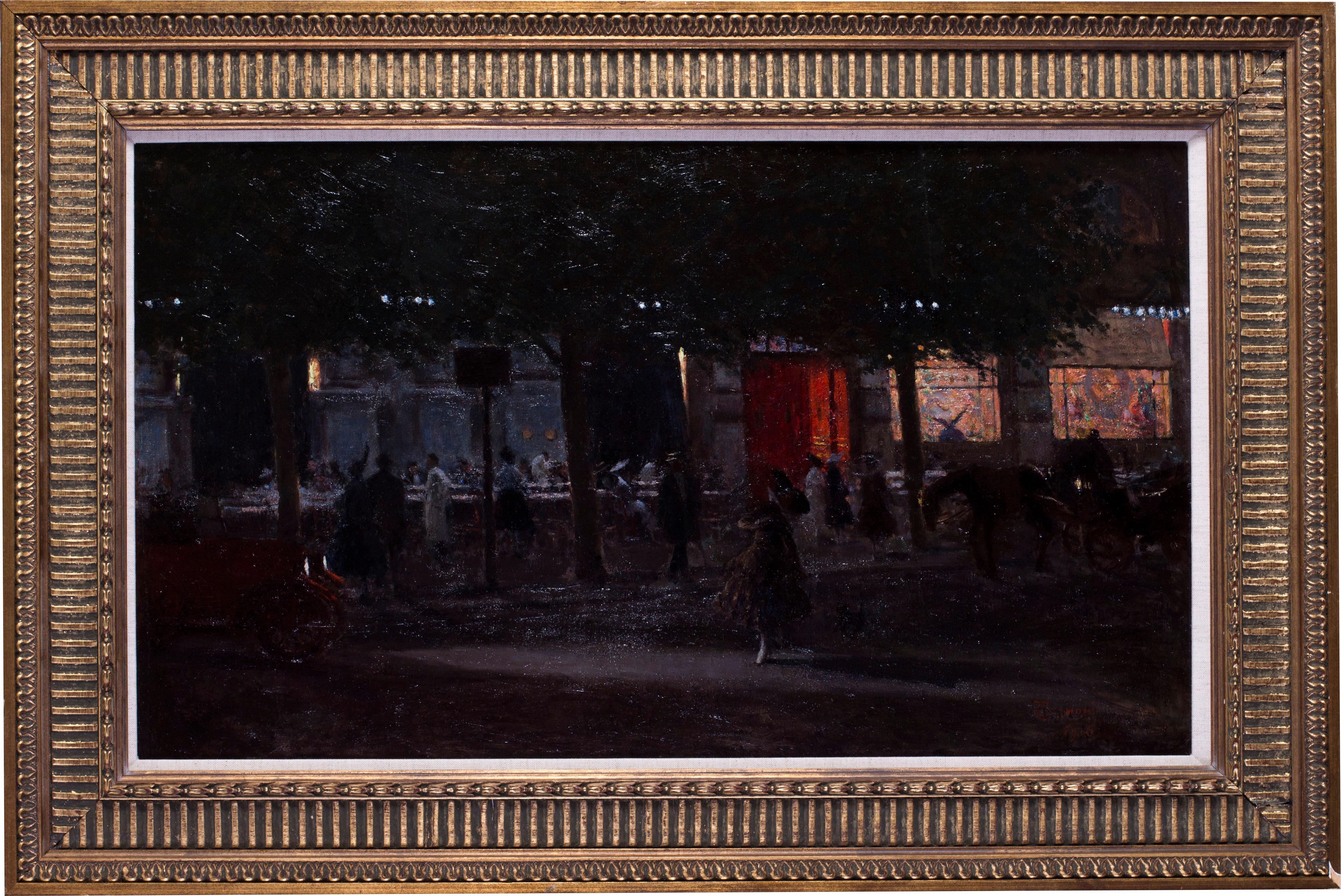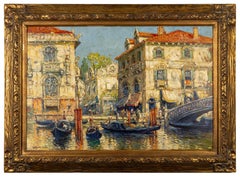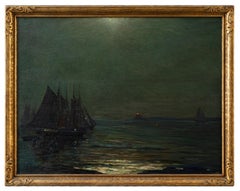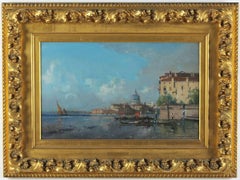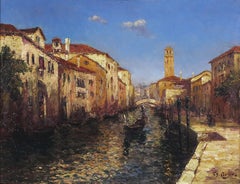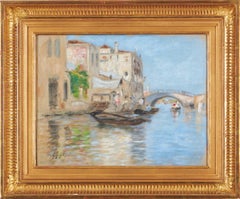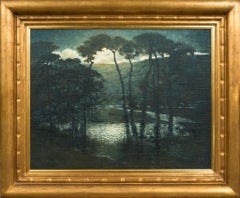Items Similar to Moonlight Over the Promenade
Want more images or videos?
Request additional images or videos from the seller
1 of 8
Wilhelm von Gegerfelt Moonlight Over the Promenade
$29,800
£22,586.69
€26,146.30
CA$42,069.86
A$46,848.14
CHF 24,460.48
MX$567,652.02
NOK 308,472.53
SEK 291,068.14
DKK 195,179.10
About the Item
Wilhelm von Gegerfelt
Swedish, 1844-1920
Moonlight Over the Promenade
Oil on canvas
27 by 45 in. W/frame 39 by 57 in.
Signed lower right
Wilhelm von Gegerfelt, also Vilhelm von Gegerfelt was a Swedish painter.
Born in Gothenburg, Gegerfelt was the son the architect Victor von Gegerfelt (1817-1915).
From 1861-1863, he studied at the Royal Danish Academy, at the Royal Swedish Academy from 1864-1867, and thereafter in Düsseldorf until 1872.
He then went to Paris where he developed a new technique joining Alfred Wahlberg as one of the first Swedes to represent the Modern Breakthrough in Nordic art.
He travelled to the north coast of France, to Italy and to England, painting landscapes of Venice's lagoons and the English chalk cliffs, in addition to scenes of summer evenings in Sweden.
His works can be seen in the National Museum in Stockholm, in the Gothenburg Museum of Art and in Skagens Museum.
Gegerfelt exhibited in Monaco from 1883 and won a silver medal at the Vienna exhibition the same year. In Paris, he sold his paintings to the Duke of Bassano as well as to Goupil and Cie.
Gagerfelt spent his later life in the fishing village of Torekov in the south of Sweden.
Provenance:
Bukowskis, Stockholm, December 4, 2001, Lot 65;
Private New England Collection
Le Trianon Fine Art & Antiques
Alexander Avenard Collection
Art G259
- Creator:Wilhelm von Gegerfelt (1844 - 1920, Swedish)
- Dimensions:Height: 39 in (99.06 cm)Width: 57 in (144.78 cm)Depth: 3 in (7.62 cm)
- Medium:
- Movement & Style:
- Period:
- Condition:
- Gallery Location:Sheffield, MA
- Reference Number:Seller: Art G2591stDibs: LU70037848542
About the Seller
4.3
Vetted Professional Seller
Every seller passes strict standards for authenticity and reliability
1stDibs seller since 2017
56 sales on 1stDibs
Typical response time: 12 hours
- ShippingRetrieving quote...Shipping from: Sheffield, MA
- Return Policy
Authenticity Guarantee
In the unlikely event there’s an issue with an item’s authenticity, contact us within 1 year for a full refund. DetailsMoney-Back Guarantee
If your item is not as described, is damaged in transit, or does not arrive, contact us within 7 days for a full refund. Details24-Hour Cancellation
You have a 24-hour grace period in which to reconsider your purchase, with no questions asked.Vetted Professional Sellers
Our world-class sellers must adhere to strict standards for service and quality, maintaining the integrity of our listings.Price-Match Guarantee
If you find that a seller listed the same item for a lower price elsewhere, we’ll match it.Trusted Global Delivery
Our best-in-class carrier network provides specialized shipping options worldwide, including custom delivery.More From This Seller
View AllVenetian Canal
Located in Sheffield, MA
Arthur Vidal Diehl
British, 1870-1929
Venetian Canal
Oil on canvas
24 by 36 in, w/ frame 32 by 44 in
Signed lower left
Best known for his sand dun...
Category
Early 20th Century Impressionist Landscape Paintings
Materials
Oil
Ships in the Moonlight
Located in Sheffield, MA
Charles Jay Taylor
American, 1855-1929
Ships in the Moonlight
Oil on Canvas
32 ¼ by 42 in, w/ frame 36 ¾ by 46 ¾ in
Signed lower left
Charles Jay Taylor was born in New York in 185...
Category
Late 19th Century Barbizon School Landscape Paintings
Materials
Oil
Vue De Venise
By Henri Duvieux
Located in Sheffield, MA
Henri Duvieux
French, 1855 – 1920
Vue De Venise
Oil on canvas
15 ¾ in. by 25 ½ in. W/frame 25 ¾ by 35 ½ in.
Signed lower right
Henri Duvieux was an ar...
Category
1880s Post-Impressionist Landscape Paintings
Materials
Oil
$12,800
A Venice Canal
By Charles Cousin
Located in Sheffield, MA
Charles Cousin
French, 1904-1972
A Venice Canal
Oil on canvas
20 by 26 in. W/frame 28 by 34 in.
Signed lower right
Charles made his debut at the Sal...
Category
1930s Post-Impressionist Landscape Paintings
Materials
Oil
Grand Canal, Venice
By George Henry Bogert
Located in Sheffield, MA
George Henry Bogert
American, 1864-1944
Grand Canal, Venice
Oil on Board
20 by 30 in, w/ frame 31 ½ by 41 ¾ in
Signed lower left
Born in New York...
Category
Early 20th Century Barbizon School Landscape Paintings
Materials
Oil
Septembre, La Meuse a Dordrecht
By Marie Joseph Léon Clavel
Located in Sheffield, MA
“I Will”, Marie-Joseph-Leon-Clavel
French, 1850-1923
Septembre, La Meuse a Dordrecht
Oil on canvas, Signed
13 ¼ by 19 ½ in. W/frame 23 ¼ by 29 ½ in.
Marie-Joseph-Leon-Clavel took ...
Category
1890s Post-Impressionist Landscape Paintings
Materials
Oil
You May Also Like
Venetian Canal
Located in Wiscasett, ME
An oil on canvas signed in the lower left and presented in a gilded frame under glass. A wonderful scene of a sunny day on the canal in Venice, Italy. Measuring 20.25" x 24.25" inclu...
Category
Early 1900s Impressionist Landscape Paintings
Materials
Oil Pastel, Oil
View Of Venice In The Moonlight, 19th Century French Impressionist School
Located in Blackwater, GB
View Of Venice In The Moonlight, 19th Century
French Impressionist School - Signed Indistinctly
Large 19th century French Impressionist view of Venice in the moonlight, oil on can...
Category
19th Century Landscape Paintings
Materials
Canvas, Oil
$3,514 Sale Price
20% Off
Claire de Lune - Moonlight - British 1916 Impressionist landscape oil painting
By Joseph Vickers De Ville
Located in Hagley, England
This stunning British Impressionist landscape oil painting is by noted British artist Joseph Vickers de Ville. It is entitled Clair de Lune verso and dated 1916-1919. Clair de Lune, ...
Category
1910s Impressionist Landscape Paintings
Materials
Oil
Moonlit Tranquility: Hugo Carlberg’s Atmospheric Nocturne, c. 1910–1913
Located in Stockholm, SE
A rare and poetic nocturne by Swedish artist Hugo Carlberg, Moonlight evokes the hushed stillness of a moonlit landscape. Silvery reflections shimmer across the water as tall trees c...
Category
1910s Post-Impressionist Landscape Paintings
Materials
Oil, Board
$4,648 Sale Price
20% Off
Impressionistic Seascape Venice Painting Michael Budden Moonlight on the Canal
By Michael Budden
Located in Chesterfield, NJ
Moonlight on the Canal, Venice
oil/panel
12 x 16 unframed, 18.38 x 22.38 framed
Moonlight on the Canal is a beautiful oil painting on canvas panel by award winning contemporary arti...
Category
21st Century and Contemporary American Impressionist Landscape Paintings
Materials
Oil
Milan at night, early 20th Century oil painting by Amerino Cagnoni
By Amerino Cagnoni
Located in Petworth, West Sussex
Amerino Cagnoni (Italian, 1855-1923)
Luci della sera (Evening Lights), Milan
oil on panel
signed `ACagnoni/1916’ (lower right)
16.1/8 x 27.1/2 in. (41 x 70 cm.)
He initially studied classical education, but abandoned studies to take a job as director of a textile mill in Brianza, then moved to Asti as secretary of a wealthy family. At age 19 he enrolled as a student of Brera Academy, where he stayed for seven years. He painted The daughter of Curzio Pichena, a subject from the novel by Guerazzi. His Episode of the War of Italian Independence...
Category
Early 20th Century Impressionist Figurative Paintings
Materials
Oil, Panel
